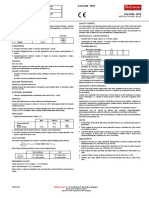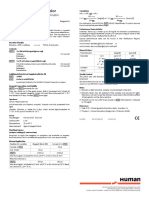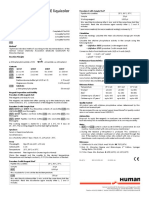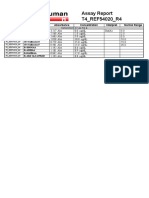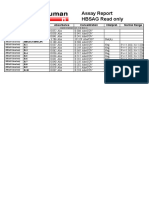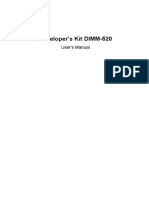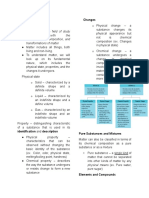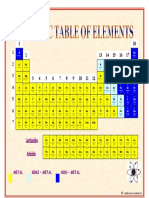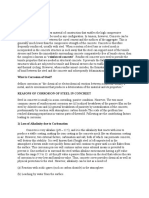TOTAL PROTEIN Liquicolor
TOTAL PROTEIN Liquicolor
Uploaded by
MaherCopyright:
Available Formats
TOTAL PROTEIN Liquicolor
TOTAL PROTEIN Liquicolor
Uploaded by
MaherOriginal Title
Copyright
Available Formats
Share this document
Did you find this document useful?
Is this content inappropriate?
Copyright:
Available Formats
TOTAL PROTEIN Liquicolor
TOTAL PROTEIN Liquicolor
Uploaded by
MaherCopyright:
Available Formats
Total Protein Iiquicolor Performance Characteristics
Linearity:
Photometric Colorimetric Test for Total The test is linear up to a protein concentration of 12 g/dl or 120 g/l. Dilute
Proteins samples with a higher concentration 1 + 1 with physiological saline (0.9%).
Multiply the result by 2.
Biuret Method Typical performance data can be found in the Verification Report, acces-
Package Size sible via:
[REF] 10570 1 x 1000 ml Complete Test Kit www.human.de/data/gb/vr/su-prot.pdf or
157004 4 x 100 ml Complete Test Kit www.human-de.com/data/gb/vr/su-prot.pdf
[IVD]
Normal Range in Serum or Plasma 2
Method Normal born babies 4.6 - 7.0 g/dl or 46 - 70 g/l
Cupric ions react with protein in alkaline solution to form a purple com- Children from 3 years and adults 6.6 - 8.7 g/dl or 66 - 87 g/l
plex. The absorbance of this complex is proportional to the protein con-
centration in the sample. Quality Control
All control sera with values determined by this method may be employed.
Contents
We recommend the use of our HUMATROL quality control serum based on
[RGT] 4 x 100 ml or 1 x 1000 ml Colour reagent
animal serum or our SERODOS based on human serum.
Sodium hydroxide 200 mmoI/l
Potassium sodium tartrate 32 mmol/l Automation
Copper sulfate 12 mmol/l Proposals to apply the reagents on analyzers are available on request.
Potassium iodide 30 mmoI/l Each laboratory has to validate the application in its own responsibility.
Irritant R 36/38
Notes
[STD] 1 x 3 ml Standard
1. The sample blank for clear, colourless sera is equivalent to 0.2 g/dl and
Protein 8 g/dI can therefore be ignored. A sample blank must be determined for visi-
or 80 g/l bly hemolytic, icteric and lipemic sera by pipetting 20 μl sample to 1000
Sodium azide 0.095 % μl physiological saline and measuring against dist. water. The
absorbance of the sample blank has to be subtracted from the absorb-
Reagent Preparation and Stability
ance of the sample.
[RGT] and [STD] are ready for use.
2. The colour reagent contains sodium hydroxide which is irritant. In case
They are stable even after opening up to the given expiry date when of contact with skin and mucous membranes wash with copious
stored at 2...25°C. Contamination after opening must be avoided. amounts of water.
Specimen 3. [STD] contains sodium azide as preservative (0.095%). Do not swallow.
Serum, heparinised or EDTA-plasma. Avoid contact with skin and mucous membranes.
4. A slight sediment may develop as [RGT] ages. Do not include this
Stability in Serum sediment in the reaction mixture.
Up to 1 month at 2...8°C, up to 1 week at 15...25°C.
References
Assay 1. Weichselbaum, T. E., Amer. J. Clin. Path. 16, 40-48 (1946)
Wavelength: Hg 546 nm, 520 – 580 nm
2. Josephson, B., Gyllenswärd, C., Scand. J. Clin. Lab. Invest. 9, 29 (1957)
Optical path: 1 cm
Temperature: 20...25°C SU-PROT INF 157001 GB 05-2007-16 |
Measurement: Against reagent blank.
OnIy one reagent blank per series is required.
Pipetting Scheme
Pipette into cuvettes Reagent blank Sample / [STD]
Sample / [STD] --- 20 μl
[RGT] 1000 μl 1000 μl
Mix, incubate for 10 min. at 20...25°C. Measure the absorbance of the
sample and [STD] against the reagent blank within 30 min. (ΔA)
Calculation of the Protein Concentration
1. With factor:
C = 19 x ΔA [g/dl] or C = 190 x ΔA [g/l]
2. With standard:
ΔA sample
C = 8 x ⎯⎯⎯⎯⎯⎯⎯ [g/dl]
ΔA [STD]
or
ΔA sample
C = 80 x ⎯⎯⎯⎯⎯⎯⎯ [g/l]
ΔA [STD]
Human Gesellschaft für Biochemica und Diagnostica mbH
Max-Planck-Ring 21 · 65205 Wiesbaden · Germany
Telefon +49 6122-9988-0 · Telefax +49 6122-9988-100 · e-Mail human@human.de
You might also like
- Pearson Edexcel A Level Chemistry Year 1 and Year 2Document667 pagesPearson Edexcel A Level Chemistry Year 1 and Year 2Rameesha Malik100% (2)
- SGPT (ALT) - Kit InsertDocument2 pagesSGPT (ALT) - Kit InsertDharmesh Patel100% (1)
- Coatings Formulation: Bodo Müller - Ulrich PothDocument285 pagesCoatings Formulation: Bodo Müller - Ulrich PothAdnan Hussain100% (1)
- 21505IDocument1 page21505INisa Javadd100% (2)
- Calcium MTBDocument1 pageCalcium MTBRisqon Anjahiranda Adiputra75% (4)
- Urea (Ned Method) : CODE NO. PACK SIZE Reagent 1 Reagent 2 Reagent 3Document1 pageUrea (Ned Method) : CODE NO. PACK SIZE Reagent 1 Reagent 2 Reagent 3Dharmesh PatelNo ratings yet
- Principle of The Method Metrological Characteristics: Bromocresol GreenDocument1 pagePrinciple of The Method Metrological Characteristics: Bromocresol GreenRisqon Anjahiranda Adiputra100% (2)
- Glucose PDFDocument1 pageGlucose PDFjef1234321100% (1)
- A Amylase DirectDocument1 pageA Amylase DirectRisqon Anjahiranda Adiputra0% (1)
- Aspartate Aminotransferase (Ast-Got)Document1 pageAspartate Aminotransferase (Ast-Got)Risqon Anjahiranda Adiputra100% (3)
- Bili Total RandoxDocument2 pagesBili Total RandoxJesus Guillermo Caceres Fernandez100% (6)
- Bilirubin (Total and Direct)Document1 pageBilirubin (Total and Direct)Risqon Anjahiranda Adiputra89% (9)
- Bilirubin Liquicolor: Photometric Colorimetric Test For Total Bilirubin DCA MethodDocument1 pageBilirubin Liquicolor: Photometric Colorimetric Test For Total Bilirubin DCA MethodMaherNo ratings yet
- Auto Liquicolor: Photometric Test For Direct (D) BilirubinDocument1 pageAuto Liquicolor: Photometric Test For Direct (D) BilirubinMaherNo ratings yet
- Principle of The Method Quality Control: Alkaline PicrateDocument1 pagePrinciple of The Method Quality Control: Alkaline PicrateRisqon Anjahiranda Adiputra100% (2)
- Insert Kit PemeriksaanDocument1 pageInsert Kit PemeriksaanNisa Javadd100% (2)
- Iiquicolor: Photometric Test For Calcium CPC MethodDocument1 pageIiquicolor: Photometric Test For Calcium CPC MethodMaherNo ratings yet
- Su Hba1cDocument1 pageSu Hba1cMaherNo ratings yet
- auto-BILIRUBIN-T LiquicolorDocument1 pageauto-BILIRUBIN-T LiquicolorMaher100% (1)
- Aspartate Aminotransferase (Ast/Got)Document2 pagesAspartate Aminotransferase (Ast/Got)Ivana BajunovicNo ratings yet
- 2a. Glukoza, GOD-PAPDocument1 page2a. Glukoza, GOD-PAPMarija KondevaNo ratings yet
- Calcium MTBDocument1 pageCalcium MTBRisqon Anjahiranda AdiputraNo ratings yet
- 11503i PDFDocument1 page11503i PDFstevie watuna75% (4)
- Calcium ArsenazoDocument1 pageCalcium ArsenazoYuni0% (1)
- HDL Direct Blt00028Document2 pagesHDL Direct Blt00028Pawan KulkarniNo ratings yet
- Urea Ingles PDFDocument1 pageUrea Ingles PDFcesiahdezNo ratings yet
- HBA1C Kit Insert DiatekDocument1 pageHBA1C Kit Insert DiatekKurnia Lavigne0% (1)
- URIC ACID Liquicolor PlusDocument1 pageURIC ACID Liquicolor PlusMaher100% (1)
- 11521i PDFDocument1 page11521i PDFNisa Javadd0% (1)
- ALKALINE PHOSPHATASE LiquicolorDocument1 pageALKALINE PHOSPHATASE LiquicolorMaher0% (1)
- 11505IDocument1 page11505ITrần Tiến ĐạtNo ratings yet
- BilirubinbeaconDocument2 pagesBilirubinbeaconMalou Andersen100% (1)
- GAMMA-GT Carboxy GPNA: BiolaboDocument2 pagesGAMMA-GT Carboxy GPNA: BiolaboFariz KasyidiNo ratings yet
- Alanine Aminotransferase (Alt-Gpt)Document1 pageAlanine Aminotransferase (Alt-Gpt)Risqon Anjahiranda Adiputra50% (2)
- Cholesterol LDL DirectDocument1 pageCholesterol LDL DirectRisqon Anjahiranda Adiputra0% (1)
- PI e BIL - TOTAL 16Document2 pagesPI e BIL - TOTAL 16ilhamNo ratings yet
- Bilirubin (Total and Direct)Document1 pageBilirubin (Total and Direct)Risqon Anjahiranda AdiputraNo ratings yet
- IDocument1 pageIRavi TejaNo ratings yet
- Bilirubin Total: ADL/V.02/110314Document1 pageBilirubin Total: ADL/V.02/110314S MNo ratings yet
- Bilirubin Direct: ADL/V.01/110314Document1 pageBilirubin Direct: ADL/V.01/110314S MNo ratings yet
- Urea Liquiuv: GLDH Method Fully Enzymatic Method For Kinetic Determi-Nation of UreaDocument1 pageUrea Liquiuv: GLDH Method Fully Enzymatic Method For Kinetic Determi-Nation of UreaMaher100% (2)
- CK-MB Liquiuv: Liquid Nac Activated Uv Test Creatine Kinase (Ec 2.7.3.2)Document1 pageCK-MB Liquiuv: Liquid Nac Activated Uv Test Creatine Kinase (Ec 2.7.3.2)Maher100% (1)
- Alkaline Phosphatase (Alp) - AmpDocument1 pageAlkaline Phosphatase (Alp) - AmpRisqon Anjahiranda Adiputra100% (4)
- TOTAL PROTEIN (Biuret Method) : Code No. Pack Size Reagent 1 Reagent 2Document1 pageTOTAL PROTEIN (Biuret Method) : Code No. Pack Size Reagent 1 Reagent 2Eddafe100% (1)
- ELISA Test For The Quantitative Determination of Total Thyroxine (T4) in Human SerumDocument2 pagesELISA Test For The Quantitative Determination of Total Thyroxine (T4) in Human SerumMaherNo ratings yet
- 11536i PDFDocument1 page11536i PDFdian saleh100% (1)
- Sodium Reagent Kit (Mono Test) : Colorimetric MethodDocument1 pageSodium Reagent Kit (Mono Test) : Colorimetric MethodFazal RazaNo ratings yet
- Creatine Kinase MB (CK MB)Document1 pageCreatine Kinase MB (CK MB)Risqon Anjahiranda Adiputra100% (3)
- 101 0422 - BILI - T&D e 2Document2 pages101 0422 - BILI - T&D e 2S MNo ratings yet
- HDL RandoxDocument4 pagesHDL RandoxJesus Guillermo Caceres FernandezNo ratings yet
- Ft4 Ii: Free ThyroxineDocument4 pagesFt4 Ii: Free Thyroxinehairi100% (1)
- Uric Acid (Human)Document1 pageUric Acid (Human)m sdNo ratings yet
- URIC ACID LiquicolorDocument1 pageURIC ACID LiquicolorMaherNo ratings yet
- CreatinineDocument1 pageCreatinineDesiNo ratings yet
- Alkaline Phosphatase (Alp) - DeaDocument1 pageAlkaline Phosphatase (Alp) - DeaRisqon Anjahiranda Adiputra100% (2)
- ALKALINE PHOSPHATASE Opt. LiquicolorDocument1 pageALKALINE PHOSPHATASE Opt. LiquicolorMaher100% (1)
- Acid Phosphatase (Acp)Document1 pageAcid Phosphatase (Acp)Risqon Anjahiranda AdiputraNo ratings yet
- Bab 8.1.2.11 Sop Pengolahan LimbahDocument1 pageBab 8.1.2.11 Sop Pengolahan Limbahrofi husaeni fahmiNo ratings yet
- Sgot Roche c111Document4 pagesSgot Roche c111Harditya FirdhausNo ratings yet
- Albumin Liquicolor: Photometric Colorimetric Test For Albumin BCG-MethodDocument1 pageAlbumin Liquicolor: Photometric Colorimetric Test For Albumin BCG-MethodMaher100% (1)
- GA4710 00-Total ProteinsDocument2 pagesGA4710 00-Total ProteinsTrần Thanh ViệnNo ratings yet
- Chloride LDocument1 pageChloride LMaherNo ratings yet
- Assay Report T4 - REF54020 - R4Document1 pageAssay Report T4 - REF54020 - R4MaherNo ratings yet
- Toxo Igg 09 02 2023Document1 pageToxo Igg 09 02 2023MaherNo ratings yet
- LED OT Light OT Table PendantsDocument11 pagesLED OT Light OT Table PendantsMaherNo ratings yet
- شغل امسDocument2 pagesشغل امسMaherNo ratings yet
- Assay Report T3 - REF54010 - R4Document1 pageAssay Report T3 - REF54010 - R4MaherNo ratings yet
- El PsaDocument2 pagesEl PsaMaherNo ratings yet
- Potassium Enz Cobas c-701 702Document2 pagesPotassium Enz Cobas c-701 702MaherNo ratings yet
- Anti HCV 07 02 2023Document1 pageAnti HCV 07 02 2023MaherNo ratings yet
- Patient MonitorDocument4 pagesPatient MonitorMaherNo ratings yet
- Dabic-5 8-Bit Serial Input Latched Sink Drivers: Description Features and BenefitsDocument8 pagesDabic-5 8-Bit Serial Input Latched Sink Drivers: Description Features and BenefitsMaherNo ratings yet
- Su Hba1cDocument1 pageSu Hba1cMaherNo ratings yet
- HBsAg 1 01 20230Document1 pageHBsAg 1 01 20230MaherNo ratings yet
- Dim520dk UmDocument24 pagesDim520dk UmMaherNo ratings yet
- URIC ACID LiquicolorDocument1 pageURIC ACID LiquicolorMaherNo ratings yet
- Bios Dimm520Document21 pagesBios Dimm520MaherNo ratings yet
- El Ca153Document2 pagesEl Ca153MaherNo ratings yet
- Dengue IgGDocument2 pagesDengue IgGMaherNo ratings yet
- Dengue IgMDocument2 pagesDengue IgMMaherNo ratings yet
- El LHDocument2 pagesEl LHMaherNo ratings yet
- 241-244 WittexDocument4 pages241-244 WittexMaherNo ratings yet
- XSZ N107Series BrochureDocument1 pageXSZ N107Series BrochureMaherNo ratings yet
- El-Cortsol 2Document3 pagesEl-Cortsol 2MaherNo ratings yet
- El PRLDocument2 pagesEl PRLMaherNo ratings yet
- Ahmed Ali Ahmed Abdo AlodainiDocument2 pagesAhmed Ali Ahmed Abdo AlodainiMaherNo ratings yet
- Jflex - 3Comgpiopccard-Usb Jflex - 4comgpiopccard: Document Revision 1.0Document23 pagesJflex - 3Comgpiopccard-Usb Jflex - 4comgpiopccard: Document Revision 1.0MaherNo ratings yet
- El ProgDocument2 pagesEl ProgMaherNo ratings yet
- Total IgEDocument2 pagesTotal IgEMaherNo ratings yet
- Human Service Bulletin: Humastar 100/200/300Sr HSB No 0024Document5 pagesHuman Service Bulletin: Humastar 100/200/300Sr HSB No 0024MaherNo ratings yet
- 0171-1330 Supply of AudiometerDocument9 pages0171-1330 Supply of AudiometerMaherNo ratings yet
- Hamzah Sultan A. Al-Shaibani: ExperienceDocument3 pagesHamzah Sultan A. Al-Shaibani: ExperienceMaherNo ratings yet
- 1 s2.0 S0014305715000464 MainDocument10 pages1 s2.0 S0014305715000464 MainHouda ElmoulouaNo ratings yet
- Master Debinding Curves For Solvent Extraction of Binders in ... R M GermanDocument5 pagesMaster Debinding Curves For Solvent Extraction of Binders in ... R M GermanTae-Shik YoonNo ratings yet
- Pharaoh's SerpentDocument19 pagesPharaoh's SerpentWhitneyNo ratings yet
- Effect of Oligothienyl Chain Length On Tuning The Solar Cell PerformanceDocument11 pagesEffect of Oligothienyl Chain Length On Tuning The Solar Cell PerformanceELOISA ADELAIDA VALADEZ AVINANo ratings yet
- Chem Ease 222Document10 pagesChem Ease 222Dastan BarakkaNo ratings yet
- Fabrication and Analysis of The Properties of Coconut Shell Ash Reinforced Aluminum356 Composite IJERTV7IS090087Document6 pagesFabrication and Analysis of The Properties of Coconut Shell Ash Reinforced Aluminum356 Composite IJERTV7IS090087HussamNo ratings yet
- Inorganic and Organic Chemistry Prelims ReviewerDocument33 pagesInorganic and Organic Chemistry Prelims ReviewerMary Ann C RecañaNo ratings yet
- Mode of Occurrence of Ore BodiesDocument20 pagesMode of Occurrence of Ore BodiesNi8furyNo ratings yet
- LESSON PLAN-2-Covalent BondingDocument2 pagesLESSON PLAN-2-Covalent BondingHOWARD ZULUNo ratings yet
- HARLAND Desiccant Dryers - Jan 2020Document21 pagesHARLAND Desiccant Dryers - Jan 2020bagusNo ratings yet
- Geology of Southwestern Nigeria Basement ComplexDocument5 pagesGeology of Southwestern Nigeria Basement Complexjuniorokoronta100% (1)
- Lecture Plan-Chemistry - Lecture Plan-Chemistry - PrayasDocument2 pagesLecture Plan-Chemistry - Lecture Plan-Chemistry - PrayasHarsh ShahNo ratings yet
- Bose 2013Document11 pagesBose 2013Khánh TrầnNo ratings yet
- Exercise 4 Protoplasm and Its Characteristics: Procedure: I. Dispersal SystemDocument4 pagesExercise 4 Protoplasm and Its Characteristics: Procedure: I. Dispersal SystemJerjer KingNo ratings yet
- Periodic TableDocument1 pagePeriodic TableSubbash EkambaramNo ratings yet
- Moletronics: Towards New Era of NanotechnologyDocument3 pagesMoletronics: Towards New Era of NanotechnologySatish Kumar KollaNo ratings yet
- Tolonate 20100311Document12 pagesTolonate 20100311Alejandro MejíaNo ratings yet
- (Solved) Discuss Post-Translational Modification of Proteins and Provide Two Examples of Modifications and Describe It. - Course Hero PDFDocument3 pages(Solved) Discuss Post-Translational Modification of Proteins and Provide Two Examples of Modifications and Describe It. - Course Hero PDFAriff Muhaimin AhmadNo ratings yet
- What Is Corrosion of Steel?Document7 pagesWhat Is Corrosion of Steel?Afia.S.HameedNo ratings yet
- Revised Syllabus MSC Chemistry Sem 1 & 2 (20072020)Document25 pagesRevised Syllabus MSC Chemistry Sem 1 & 2 (20072020)yur fanNo ratings yet
- Process of de Mineralization PlantDocument13 pagesProcess of de Mineralization Plantmoinulriad100% (4)
- Effect of Alkali Treatment On Heavy Metals Adsorption Capacity of Sewage SludgeDocument7 pagesEffect of Alkali Treatment On Heavy Metals Adsorption Capacity of Sewage SludgeMuhanned AljeboryNo ratings yet
- Effects of Composition and Processing SEBS OIL PPDocument25 pagesEffects of Composition and Processing SEBS OIL PPBahadır Uğur AltunNo ratings yet
- Organic Chemistry NotesDocument24 pagesOrganic Chemistry NotesSweatNo ratings yet
- SizingDocument39 pagesSizingToa 97No ratings yet
- Law of Conservation of Mass QuizDocument6 pagesLaw of Conservation of Mass QuizLeormhan Jacob Dela CruzNo ratings yet
- Guide To Chemical Grouting of Joints and Cracks in Concrete MERL-2013-58Document38 pagesGuide To Chemical Grouting of Joints and Cracks in Concrete MERL-2013-58chutton681No ratings yet
- Abdel-Magid, A. F., Maryanoff, C. A., & Carson, K. G. (1990) - Reductive Amination of Aldehydes and Ketones by Using Sodium Triacetoxyborohydride. Tetrahedron Letters, 31 (39), 5595-5598Document4 pagesAbdel-Magid, A. F., Maryanoff, C. A., & Carson, K. G. (1990) - Reductive Amination of Aldehydes and Ketones by Using Sodium Triacetoxyborohydride. Tetrahedron Letters, 31 (39), 5595-5598de paloNo ratings yet




